mobile View, to the German Version tap the flag


- in the 8th century Duchy of Cantabria
- today Autonomous Region of Spain
• Flag
• Historical and other Flags
• Meaning/Origin of the Flag
• Coat of Arms
• Meaning/Origin of the Coat of Arms
• Map of the autonomous regions of Spain
• Map of the historic Kingdoms on the Iberian Peninsula
• Numbers and Facts
• History
• Origin of the Country's Name
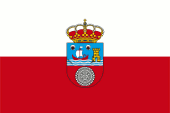
Flag of Cantabria,
ratio = 2:3,
Source, by: Flags of the World






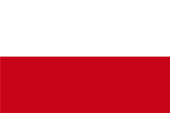
1845, 1982–1984,
Flag of Cantabria,
Source, by: World Statesmen



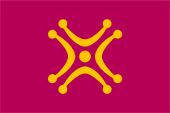
Lábaru,
unofficial national flag of the Cantabrians,
ratio = 2:3,
Source, by: Oren neu dag, CC BY-SA 3.0, via Wikimedia Commons




since 1976,
Flag of ADIC,
ratio = 2:3,
Source, by: Greti85, CC BY-SA 4.0, via Wikimedia Commons




The today’s flag of Cantabria was introduced on 30th of December in 1981. It shows two horizontal stripes in white and red and since the 22nd of December in 1984 the coat of arms of Cantabria in the middle. The coat of arms is a little bit moved up because of optic reasons. The flag is frequently reproduced without coat of arms. The design of the flag goes back to a draft from 1845. Another flag of great regional importance is the "Lábaro Cántabro", the Cantabrian Labarum, which became popular only a few years ago. It goes back to the appearance of the flags of the Roman legions and picks up on the reverence that the Roman troops had for their insignia. The motif is symbolism inspired by the Cantabrian stelae from pre-Roman times: four crescents facing each other in twos. Another regional flag is the flag of the ADIG (Asociación para la Defensa de los Intereses de Cantabria - Association for the Defence of Cantabria's Interests), a flag with three vertical stripes in green, grey and light blue. In most autonomous regions of Spain, the more recent flag history already began in the years before the granting of the Statute of Autonomy with a flag without arms, because the arms had often not even been decided yet. After all, it has mostly become accepted that the flag with the coat of arms is used by the regional authorities or on official occasions and the flag without the coat of arms is to be used quasi for private, decorative purposes.
Source: Wikipedia (ES),
Wikipedia (EN),
Volker Preuß


since 1984,
Coat of arms of Cantabria,
Source, by: Wikipedia (ES)

The today’s coat of arms of Cantabria was introduced on 22nd of December in 1984. The blazon is separated and shows in its upper half a scenery from the year 1248 as merchants from Canatbria broke though the chain-barrier of the port of the moresque town Sevilla and played with this doing an important roll in the liberation of this town. The lower half of the shield is red and shows a silvery disc with geometric patterns, a representation of the sun taken from the Cantabrian stelae of pre-Roman times. A royal crown appears above the shield.
Source: Wikipedia (ES),
Volker Preuß

The autonomous Regions of Spain:
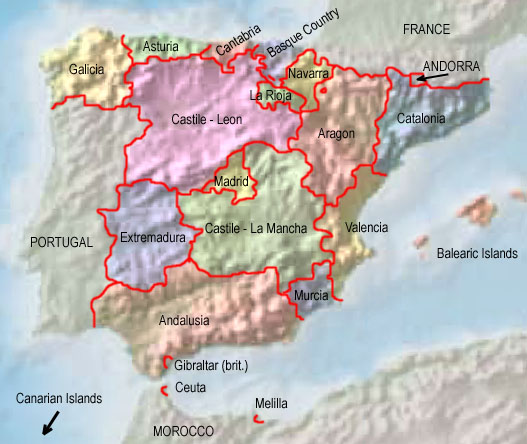
Source: Freeware, University of Texas Libraries, modyfied by: Volker Preuß

Map of the historic Kingdoms on the Iberian Peninsula (ca. 1220):
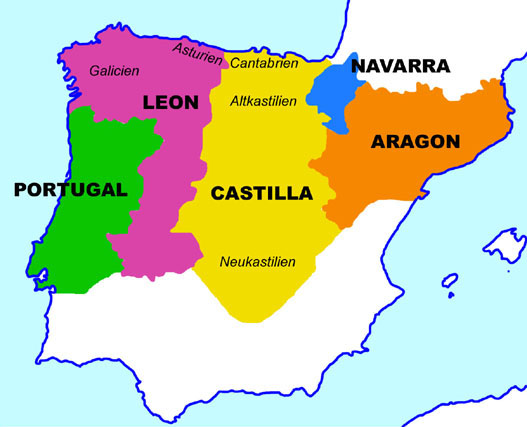
Map: Volker Preuß

Area: 2.054 square miles
Inhabitants: 585.402 (2022), mostly Cantabrian Castilians (Spaniards)
Density of Population: 286 inh./sq.mi.
Capital: Santander, 171.693 inh. (2022)
official Language: Spanish (Castillian)
Currency: Spanish (Euro) currency
Time Zone: GMT + 1 h
Source: Wikipedia (EN)

early age · settlement of the today's Cantabria by the Indo-European people of the Cantabrians (Latin: Cantabri)
antiquity · immigration of Iberians
ca. 600 B.C. · immigration of Celts, the Cantabrians become to Celtiberians by mixing
218–201 B.C. · Second Punic War, the Roman Empire acquires the possessions of Carthago in Iberia, subjugation of whole Iberia until the year 19 B.C., in Cantabria partially Roman settlement, partial romanization
ca. 400 A.D. · Great Transmigration (Migration Period), immigration of Alans, Suebs and Western Goth, the today’s Cantabria becomes a part of the Empire of the Western Goth
711–714 · annihilation of the Empire of the Western Goth by from northern Africa coming Arabs, the Western Goth retreat to Asturia and Cantabria where they start to mix with the Celtiberian Cantabrians, formation of the Western Goth Duchy of Cantabria under Duke Peter, erection of the capital Amaya, the Arabs are not successful in the conquest of Cantabria
739 · election of Alfons I., son of Duke Peter of Cantabria, to the Prince (King) of Asturia, unification of Asturia and Cantabria
ca. 800 · Alfons II. (King of Asturia) defends Cantabria in the battle of Los Barrios de Luna against the Arabs and conquers them utterly
further history data look Asturia
14th–15th century · the ports of Cantabria gain big importance for the trade with wool from Castile
18th–19th century · the ports of Cantabria gain big importance for the trade of Spain with its colonies in America
1808–1813 · is occupied by French troops, guerilla war against the occupators
1833 · the until that point in time in Spain existing partial kingdoms and regions become divided in provinces, the Kingdom of Asturia in the provinces of Oviedo and Santander (Cantabria)
1936–1939 · Spanish civil war, Cantabria struggles for a short time (until 1937) on the side of the socialistic central government
11th of January 1982 · Cantabria gets the statute of autonomy within Spain (former province of Santander), establishment of the "Autonomous Community of Cantabria"
Source: Wikipedia (ES),
World Statesmen,
Volker Preuß

The name "Cantabria" comes from the Indo-European tribe of the Cantabrians, who settled here in early and ancient times. The name of this people seems to be of Basque origin, perhaps they also spoke Basque, the oldest language in Europe, because the Basque word "kant" means "near" and the river Ebro is called "abre" in Basque. The Cantabrians were the people who lived "near the Ebro".
Source: Handbuch der geographischen Namen


![]()














